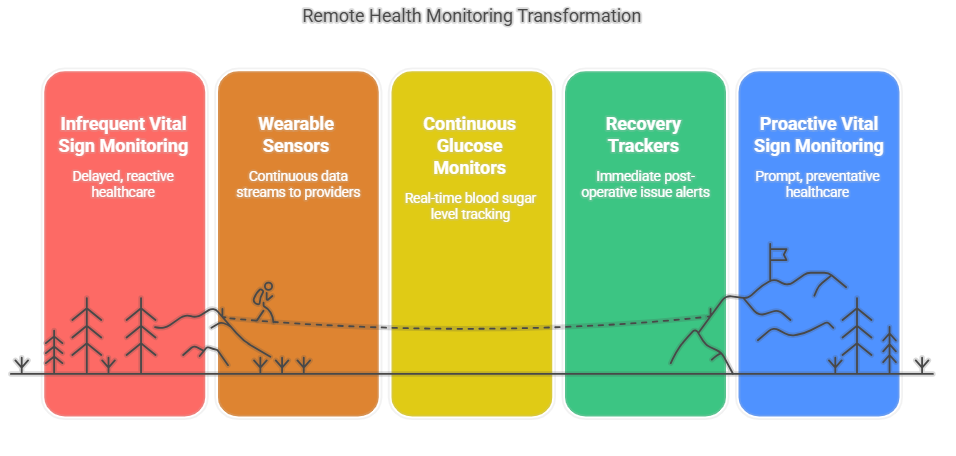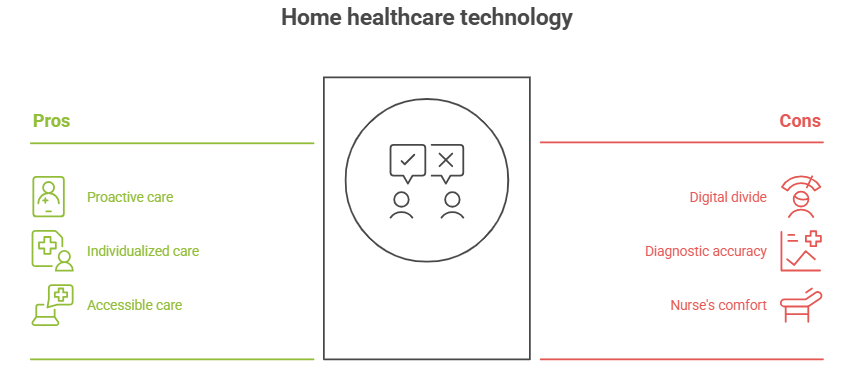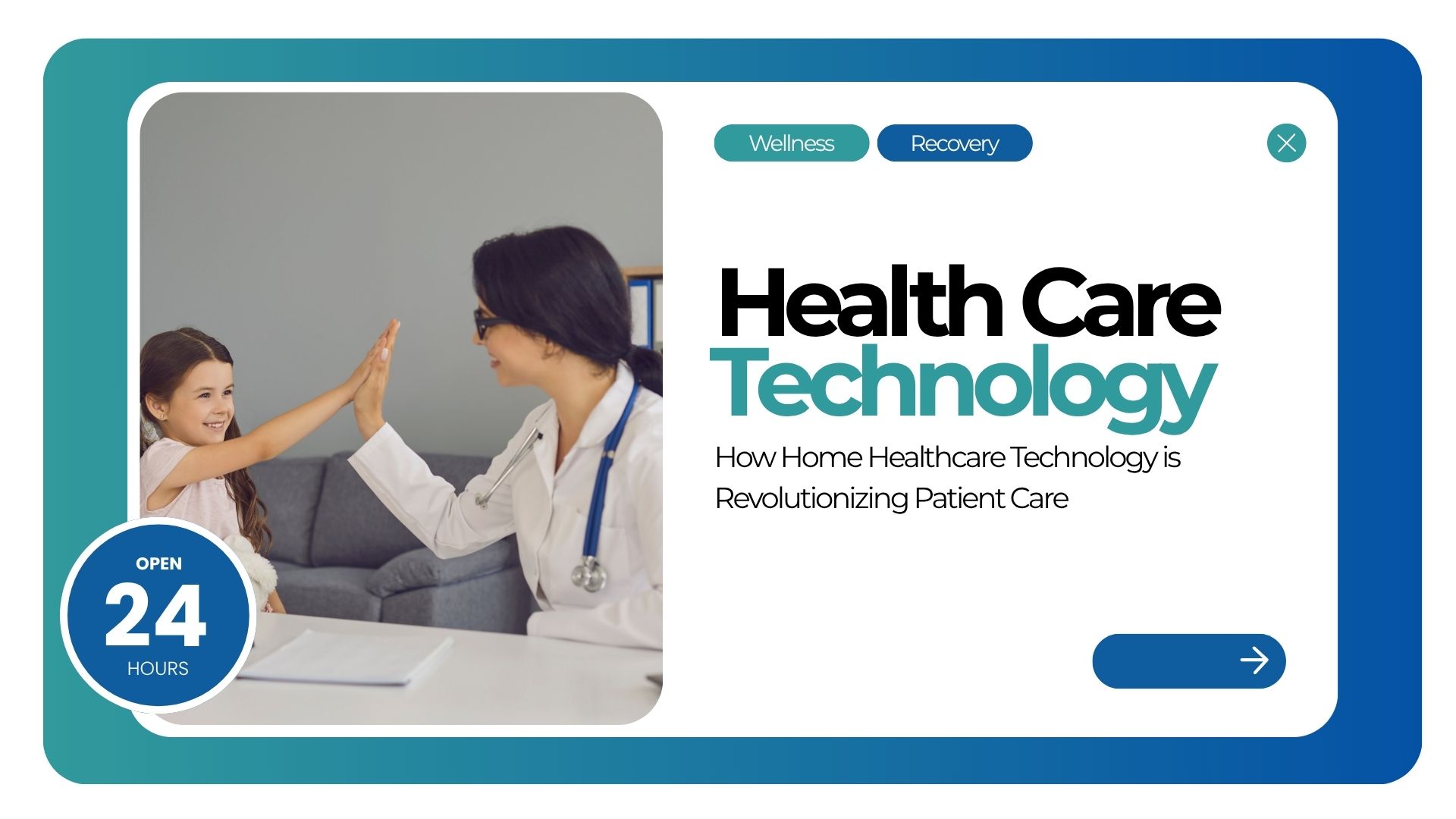Introduction:
Our approach to healthcare is rapidly evolving. And truthfully? Time is of the essence. For many years, getting top-notch medical care outside of a clinic or hospital seemed unattainable (and possibly dangerous). However, patients can now manage chronic conditions, recuperate from surgeries, and even receive diagnostics without ever leaving their living rooms, all thanks to the quick advancements in home healthcare technology.
It is transformative rather than merely convenient. Furthermore, the move toward home-based solutions is addressing gaps we were unaware existed, despite the fact that some may contend that in-person care will always be required (and they are not incorrect). How precisely is this occurring, then? Since no one needs another article that reads like a medical textbook, let’s break it down without getting too technical.
1. Remote Monitoring: Keeping Tabs Without the Hospital Gown
Vital sign monitoring no longer required frequent trips to the doctor’s office. These days, blood pressure, oxygen levels, and more can be measured by wearable technology and at-home monitoring tools (and sent straight to healthcare providers in real time).
For instance, intelligent glucose monitors. Patients with diabetes are no longer limited to excruciating finger pricks. Continuous glucose monitors (CGMs) continuously measure blood sugar levels and notify users (and their physicians) of any abnormalities. Although it’s a minor adjustment, it can have a profound impact on someone with diabetes.
It’s also not limited to long-term ailments. Recovery trackers that track heart rate, movement, and even wound healing are now available for post-operative patients to wear. Their care team is alerted right away if something appears out of the ordinary; there is no waiting for the next examination or guesswork. Simply more prompt and proactive care.

2. Telehealth: The Doctor Will Zoom You Now
Let’s face it, nobody enjoys reading a five-year-old magazine while waiting in a line. Although telehealth has been around for a while, the pandemic forced its use to explode. Right now? It is here to stay.
Virtual consultations are no longer limited to treating minor colds. Video calls are being used by specialists in cardiology, mental health, and even physical therapy to connect with patients who might otherwise miss appointments because of mobility or distance. Additionally, the ability to consult a doctor from the comfort of your couch is revolutionary for routine care, even though some things still require an in-person visit (you can’t set a broken bone over Skype).
It’s also lowering the number of no-shows. The annual cost of missed appointments to the healthcare system is billions, but with the “clinic” only a click away,
3. AI and Predictive Care: Catching Problems Before They Escalate
In healthcare, artificial intelligence used to sound like science fiction, but today it’s quietly working in the background to anticipate and stop medical emergencies.
In order to identify possible problems before they become emergencies, AI-powered platforms examine data from wearables, electronic medical records, and even patient-reported symptoms. An algorithm could, for example, identify minute variations in a heart failure patient’s weight, which is a crucial sign of fluid retention, and notify their physician to change their medication before the patient needs to be admitted to the hospital.
Is it flawless? No. Artificial intelligence still depends on human oversight, and false alarms can occur. When it does work, though, it’s like having a doctor on your side all the time (minus the awkward small talk).
Read more: How to Earn with YouTube Shorts: A Fun, Profitable Guide 2025
4. Medication Management: Because Remembering Pills is Hard
Admit it: it’s far too easy to forget to take your medication, even if you mean well. With alarms, automatic dispensing, and even the ability to notify family members in the event that a dose is missed, smart pill dispensers are resolving that issue.
Some systems even go so far as to track usage and notify users when it’s time to take a puff, such as connected inhalers for asthma patients. These tools are not only useful, but they may even save the lives of elderly patients or those with complicated medication schedules.
5. The Human Touch: Where Tech Falls Short About Healthcare
Despite all of its advantages, home healthcare technology is not a panacea. The accuracy of hands-on diagnostics and the comfort of a nurse’s presence are still incomparable. Not everyone has dependable internet access or the self-assurance to use these tools, so let’s not overlook the digital divide.
However, there is a clear trend: technology is enhancing proactive, individualized, and accessible care. The goal is to enable patients to take charge of their health in ways that were not feasible ten years ago, not to replace doctors.

Advantages of Home Healthcare Tech
Prevents Hospitalizations: Early detection of worsening conditions (e.g., COPD exacerbations) reduces ER visits by up to 50% (per a 2024 Kaiser study).
Saves Money: RPM cuts costs by $8,000 per patient annually by avoiding readmissions (Commonwealth Fund data).
Improves Access: Rural patients gain specialist consults without travel.
Empowers Patients: Real-time glucose or BP data helps people make informed daily choices.
Reduces Burden on Clinics: Automating vitals collection saves nurses 15+ hours weekly (American Nurses Association).
Limitations and Challenges of Healthcare
Tech Literacy Barriers for Healthcare: 40% of adults over 65 lack confidence using health apps (Pew Research).
Spotty Internet Access for Healthcare: 21 million Americans lack broadband, limiting telehealth in underserved areas (FCC report).
Regulatory Hurdles for Healthcare: FDA approval delays slow innovation (e.g., some AI diagnostics take 3+ years to clear).
Patient-Provider Relationship for Healthcare: Some elderly patients miss face-to-face interactions, fearing depersonalized care.
Data Overload for Healthcare: Clinicians report “alert fatigue” from excessive AI warnings (30% of which are false alarms).
The Future: What’s Next about Healthcare?
AI Chatbots for Triage: Mayo Clinic is testing an AI that asks symptom questions and prioritizes ER cases.
Smart Homes for Dementia: Motion sensors detect falls or missed meals, alerting caregivers.
VR Physical Therapy: Patients recover from strokes using guided virtual exercises.
Read more: What is Healthcare Tech?
Real-World Impact: Case Studies About Past Healthcare
Case Study 1: Remote Monitoring for Heart Failure Patients
The Problem: Heart failure patients often struggle with fluid retention, leading to frequent hospital readmissions. Traditional care relies on patients noticing symptoms (like swelling or shortness of breath) and scheduling a doctor’s visit often too late.
The Tech Solution: The Biofourmis BiovitalsHF system uses a wearable sensor to track heart rate, activity levels, and fluid status. AI analyzes trends and alerts clinicians if intervention is needed.
The Result: A 2023 Cleveland Clinic study found a 38% reduction in 30-day readmissions among patients using the system. One participant, 72-year-old Martha, avoided hospitalization when her care team adjusted her diuretics remotely after detecting early fluid buildup.
Case Study 2: Telepsychiatry for Rural Mental Health
The Problem: In Montana, where mental health providers are scarce, patients previously drove hours for therapy or went without care.
The Tech Solution: Frontier Telehealth partnered with local clinics to offer secure video therapy sessions. Patients now meet with psychiatrists via tablet, with prescriptions electronically sent to their nearest pharmacy.
The Result: A 2022 pilot showed a 52% increase in treatment adherence. Jake, a veteran with PTSD, shared: “I wouldn’t have gotten help if I had to travel. Now, I click a link and my therapist is there.”
Final Thoughts: Is This the Future?
Most likely. Although the healthcare sector is infamously slow to adapt, the advantages of home-based technology are too great to be disregarded. Better patient involvement, fewer readmissions to the hospital, and reduced expenses? It is a win-win situation.
There will undoubtedly be snags (privacy issues, technical difficulties, and the odd patient who simply wants in-person care). However, resistance will probably diminish as these tools become more widely used and intuitive. After all, wouldn’t you prefer to avoid the waiting area?
Read more: The quick advancements in home healthcare technology.
Five Key Questions (and Answers)
1. Is home healthcare technology as accurate as in-person care?
For many use cases, yes. FDA-cleared devices like ECG patches and spirometers match clinical-grade accuracy. However, physical exams (e.g., palpating a tumor) still require hands-on assessment.
2. How do elderly patients adapt to these tools in healthcare system?
Adoption varies. While 60% of seniors in a 2023 AARP survey embraced simplified devices (like voice-activated pill reminders), others struggle with touchscreens. Solution: Many programs now include tech coaching from nurses.
3. Does insurance cover these technologies in healthcare ?
Increasingly. Medicare reimburses for remote patient monitoring (RPM) codes, and private insurers are following suit. But coverage gaps remain (e.g., some AI tools are considered “experimental”).
4. What about data privacy?
HIPAA-compliant platforms encrypt data, but breaches happen. A 2023 JAMA study found 14% of health apps shared data with third parties without clear disclosure. Patients should verify privacy policies.
5. Will this replace doctors?
No, it augments them. As Dr. Lena Patel (a telehealth physician) explains: “Tech handles routine monitoring, freeing us to focus on complex cases. It’s collaboration, not replacement.”


Лучшие ИБП для бизнеса, узнайте.
Рейтинг лучших ИБП, читайте.
Почему стоит купить ИБП, узнайте больше.
Рекомендации по выбору источников бесперебойного питания, в специализированной статье.
Источники бесперебойного питания: что важно знать, здесь.
Как не ошибиться при выборе ИБП, с нашими рекомендациями.
Источники бесперебойного питания: как выбрать лучший, здесь.
Как работает источник бесперебойного питания, в нашем материале.
Как продлить срок службы источника бесперебойного питания, узнайте.
Инновации в области источников бесперебойного питания, ознакомьтесь.
Правила подключения источника бесперебойного питания, на сайте.
Как выбрать ИБП для разных нужд, с нашим руководством.
Как выбрать оптимальный ИБП, получите советы.
Сравнение ИБП: какой выбрать?, в гиде.
Советы по монтажу источников бесперебойного питания, в нашем материале.
Что выбрать: ИБП или альтернативу?, в этой статье.
Как продлить срок службы ИБП, узнайте.
Рейтинг лучших ИБП для геймеров, читайте.
Рекомендации по выбору ИБП для дома, в нашем блоге.
купить ИбП [url=https://www.istochniki-bespereboynogo-pitaniya.ru#купить-ИбП]https://www.istochniki-bespereboynogo-pitaniya.ru[/url] .